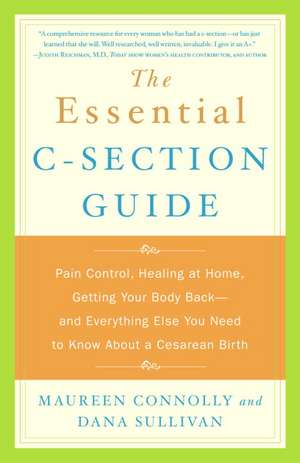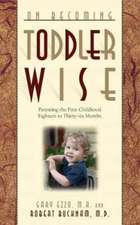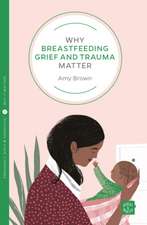The Essential C-Section Guide
Autor Maureen Connolly, Dana Sullivan, Connollyen Limba Engleză Paperback – 30 apr 2004
The Essential C-Section Guide is written not only for women to read in preparation for a scheduled c-section and for those considered “high risk” who know that a c-section may become necessary but also for women recovering from an unexpected surgical delivery. This book provides answers to important questions about what the surgery entails, what a woman can expect as she recovers, and what considerations should be made for future pregnancies and deliveries.
With frank discussions about the physical and emotional aspects surrounding a c-section, the authors share comforting wisdom about early bonding, pain control, breastfeeding, infant care, healing from surgery, postpartum exercise, partner involvement, and much more, in detail not available anywhere else.
Written by authors who have firsthand knowledge of birth by c-section, The Essential C-Section Guide is well-researched and addresses its unique concerns with intelligence and compassion.
www.broadwaybooks.com
Preț: 96.11 lei
Nou
Puncte Express: 144
Preț estimativ în valută:
18.39€ • 19.20$ • 15.22£
18.39€ • 19.20$ • 15.22£
Carte disponibilă
Livrare economică 15-29 martie
Preluare comenzi: 021 569.72.76
Specificații
ISBN-13: 9780767916073
ISBN-10: 0767916077
Pagini: 240
Dimensiuni: 133 x 204 x 16 mm
Greutate: 0.22 kg
Editura: HARMONY
ISBN-10: 0767916077
Pagini: 240
Dimensiuni: 133 x 204 x 16 mm
Greutate: 0.22 kg
Editura: HARMONY
Notă biografică
MAUREEN CONNOLLY has served on the staffs of Parenting, Family Circle, Self, and Woman’s Day and was a contributing writer/editor for venues such as The New York Times Women's Magazines, babycenter.com, and YourBabyToday.com. Her articles have appeared in Redbook, Parenting, Parents, Health, and Family Circle. DANA SULLIVAN is a contributing editor at Shape’s Fit Pregnancy. She served on the staff of Parenting and has written for numerous national magazines, including Parents, Glamour, and Redbook. Both authors delivered each of their two children via cesarean.
Extras
Chapter 1
Why a Cesarean?
"'Don't cut her open, she's not numb!' I heard the anesthesiologist yell to my OB as a team of nurses rushed me down the hall toward an operating room. 'Wait, wait, wait!' was all I could think, so stunned that I couldn't even speak. This wasn't how it was supposed to happen. 'But I'm barely in labor,' I managed to say before the anesthesiologist placed a mask over my face and instructed me to breathe. He counted to three and the lights went out. When I woke up later, it was to the news that my newborn son was on life support."
That was how one of our perfect and perfectly uneventful pregnancies (Dana's) ended. In a matter of minutes, labor shifted from ordinary to potentially disastrous and an emergency Cesarean became necessary.
Even though we had completely different experiences with our first Cesareans--Maureen labored for nine hours, pushing for two and a half of them, before it became clear that her son Jack wasn't going to come out any way but through her belly--there were many similar themes. We each had "normal," healthy pregnancies; we both felt very prepared for labor by the end of our childbirth classes; and neither of us even considered the possibility that we would have Cesareans. In the weeks after our babies' births, when we were home and well on the road to recovery following the surgery, we both felt an overwhelming sense of failure. "Why me?" and "What did I do wrong?" were questions we asked ourselves for months.
Making Sense of the Statistics
With the benefit of hindsight, we know that our Cesarean deliveries weren't the result of anything we did--or didn't do. But very few pregnant women (at least those who are not carrying multiples or have certain medical conditions) plan even for the possibility that they will give birth via c-section. More of us should; the odds that a baby born in the United States will be delivered via Cesarean are more than one in four, 26.1 percent to be exact; 18 percent of the Cesareans performed in 2002 were primary, that is, performed on women who had not had a previous Cesarean delivery.
During the past few years, there has been a lot of controversy surrounding these statistics. A number of healthcare providers, including some OB/GYNs, believe that the Cesarean birth rate in the United States is too high and, in many cases, that surgical deliveries are unnecessary. "We have turned childbirth into a medical procedure," is a frequent refrain. While we certainly don't believe that a Cesarean is the ideal way to give birth--and we would never encourage anyone to request a c-section for the sake of convenience--neither should women who have one feel that their birth experience is anything but extraordinary. Childbirth by Cesarean is still childbirth. It's also worth noting one fact that is rarely brought up by the media: medical advances during the last several decades have made c-section surgery much safer, so today many physicians will opt for a Cesarean birth well before the situation becomes desperate.
The fact that the technique now used in about 90 percent of all c-sections--called a "low transverse" incision--has fewer complications than the vertical incision that was used for many years is one reason. This refined surgical technique has made it possible for women to attempt a vaginal birth after Cesarean (called a VBAC) in subsequent pregnancies. This makes some physicians less reluctant to perform a Cesarean on a first-time mom. Another reason is developments in anesthesia. Namely, that a regional anesthetic can be used 90 percent of the time, rather than a general, which lowers the risk of complication and death from anesthesia. Now there also are a variety of antibiotics that protect against postoperative infection, which was a substantial risk historically associated with Cesarean deliveries. Finally, the number of women who are delivering babies in their thirties and forties has increased dramatically. Women between the ages of thirty and fifty-four have a 35 percent chance of delivery by Cesarean; women under twenty-nine face a 22 percent chance. (In part, that's because older women face a host of age-related risk factors, including a higher likelihood of experiencing preterm labor, which necessitate a Cesarean delivery to preserve the health of the baby.) Each of these factors has contributed to the increase in Cesarean deliveries.
During the course of our research for this book, we heard two telling comments from physicians. The first was, "When something goes wrong during labor, it generally doesn't go just a little bit wrong. Things can go from bad to tragic in a matter of minutes." The second was, "The few inches that a baby travels during childbirth is the most dangerous distance he'll travel during his whole life." With those two thoughts in mind, and before we veer into melodrama, let us state that we are grateful that we had emergency obstetric delivery options available to us. Until the early 1900s, both babies and mothers were not always expected to survive a Cesarean delivery in this country. In many parts of the world today, women still don't have the procedure available to them--and the cost in human lives is heartbreaking.
The History of the Cesarean
It is generally believed that the term "Cesarean" originated with the surgical birth of Julius Caesar. At the time of his birth, babies were delivered surgically in order to save the life of a baby whose mother was dying or already dead. But it is known that Julius Caesar's mother, Aurelia, was alive at least long enough to hear of her son's invasion of Britain--making it unlikely that his was a surgical birth. A more plausible origin for the term may have to do with Roman law under Caesar, which required that women who were beyond saving during childbirth be cut open in order to preserve the life of the baby. Babies were highly valued because they added numbers to the country's population. Another theory is that the term comes from the Latin words caedre, which means "to cut," or caesones, a label that was given to babies who were born after their mothers had died.
The first successful Cesarean delivery using Western medical techniques is credited to a female physician named James Miranda Stuart Barry, who was masquerading as a man (women were generally denied admission to medical schools) and serving in the British Army in South Africa. The surgery took place sometime between 1815 and 1821. Dr. Barry's surgical delivery probably wasn't the first successful surgical delivery in the world, however. Europeans traveling in Uganda and Rwanda in the nineteenth century also reported witnessing surgical deliveries. In these deliveries the "healer" would use wine to sedate the patient and pin the incision closed with iron needles instead of Western-style sutures.
In the mid-nineteenth century, a Massachusetts dentist successfully used diethyl ether to anesthetize a patient so he could remove a facial tumor. After that, anesthesia became widely used for many surgical procedures. It took some years before anesthesia was used for Cesareans, however, because women were still expected to "sorrow"--i.e., suffer in pain--as they brought children into the world. In the later nineteenth and early twentieth centuries, advancements in anesthesia and antiseptic formulas made it possible for surgeons to operate slowly and to properly cleanse the abdominal region, which prevented women from dying of infection and shock. By the early twentieth century, the availability of penicillin significantly reduced the number of women who died as a result of infection.
Why a Cesarean Today?
Fast forward to the twenty-first century. We now have tools that can accurately gauge how a pregnancy is progressing at every stage. By monitoring both maternal and fetal health, physicians are able to prepare for or react to situations that make a vaginal birth risky or impossible. There are dozens of scenarios that lead to Cesarean deliveries today--and unlike Roman law none is aimed at increasing the population! Many situations develop only moments before the physician decides it's time to get the baby out, either because the mother's or the baby's health is jeopardized. In other cases, both the doctor and the expectant mother know early in pregnancy that delivery via c-section is a distinct possibility. The mom-to-be may have a medical condition, such as high blood pressure, heart disease, or diabetes, that makes Cesarean the safest mode of delivery for her. She may be infected with HIV or hepatitis C, or, through ultrasound, the physician may have discovered that the baby has a condition such as spina bifida or hydrocephalus, making surgical delivery the safer route for the baby.
On occasion, physicians know at the very first prenatal visit that Cesarean is the most likely way the baby will be delivered: the mother may have fibroids that block the birth canal, or she may have a malformed pelvis due to a birth defect or an improperly healed pelvic injury. Delivering twins by Cesarean used to be routine, but today only about half of twin deliveries are surgical. The rate is higher for triplets and higher order multiples. Typically, multiples have higher rates of Cesarean deliveries than singletons because often they need to be delivered prematurely and are smaller than lone babies, both factors that put them at risk for experiencing life-threatening distress during labor.
While we cannot cover every circumstance that results in a c-section, there are a few major "indications"--to borrow the medical term--for Cesarean delivery:
Previous c-section
A prior Cesarean is the number-one reason for a surgical delivery in the United States, accounting for more than one-third of all procedures (see Table 1, "By the Numbers"). A woman who has had one c-section has better than an 80 percent chance that she'll have another with future pregnancies.
Even though the percentage of women delivering vaginally following a Cesarean has decreased--to roughly 13 percent in 2002--that 80 percent c-section rate is actually a relative improvement. Until about the mid-1950s, once a woman had had one Cesarean, the chances that subsequent deliveries would also be surgical was close to 100 percent. That's because before the widespread use of the low transverse incision, also known as a "bikini cut," the surgical technique used for Cesarean deliveries was the "classical cut." This type of incision left the woman with a long vertical scar that weakened the uterus, making it more likely to rupture during future pregnancies and deliveries. Today the classical cut is used in certain emergency situations, if the baby is lying sideways, in what's called the transverse position or if the baby is very premature or breech.
Dystocia, aka, a difficult labor
We know, there's no such thing as an easy labor! However, dystocia (dis-tow-sha) is something more than run-of-the-mill labor discomfort. Dystocia is the second most common reason cited for Cesarean delivery. The term describes a labor that has failed to progress or has become otherwise "dysfunctional," making the birth attendants feel that the baby's or the mother's safety--or both--is in danger. Reasons for a difficult labor may include a mother with a narrow pelvis, making it difficult for her to deliver a large baby (called "cephalopelvic disproportion"). It may be that the contractions aren't strong enough either to dilate the cervix fully, or to push the baby all the way through the birth canal, or it might be a combination of any of these factors.
A Change of Plans
"A week before my official due date, my obstetrician delivered the news that my daughter would probably need to be delivered via Cesarean. A sonogram showed that the baby had an unusually large head and chest; the doctor estimated her weight at nine pounds, four ounces. I'm a petite woman and have a narrow pelvis, but I was distraught when he recommended the Cesarean. When I saw her head afterward, even though I was disappointed I didn't have a vaginal birth, I was also relieved. At first I felt vulnerable for letting my doctor make this decision, but I am also thankful that I could trust him. In the end I know we did the right thing. And his estimate was right on: Emma came into the world weighing exactly nine pounds, four ounces."
--Tracey, mother of one, a Cesarean in 1998
Some women who wind up having Cesareans due to dystocia are strong and healthy and experience labor that progresses without a hitch until the cervix dilates all the way to ten centimeters. But if the baby hasn't descended into the birth canal, either because he is too large or mom's pelvis is too small, or his head is positioned in a vulnerable way, the obstetrician or midwife has a difficult decision to make. At this point the physician can recommend non-medical intervention, such as an hour of rest or a change of position. A midwife or nurse may give you a massage, or a bath (if your water hasn't broken). The labor and delivery attendants may decide to try to help both mom and Mother Nature along by administering Pitocin, a drug that strengthens contractions. Or the healthcare provider may decide to rupture the amniotic sac.
All these options fall into a category called "active management of labor," and may help the birthing process progress. But at a certain point, if labor doesn't respond to such interventions, a Cesarean is usually necessary. When labor stalls for more than about an hour--the official term is "arrest of labor"--it indicates that one of the body's protective mechanisms has kicked in. The uterus will basically stop contracting, which stalls labor and leaves the baby in a precarious place. In this situation, a surgical delivery may be called for in order to prevent a potentially catastrophic outcome.
Fetal heart rate abnormality, also called fetal distress
Most hospitals and even some birthing centers rely on fetal heart rate monitoring to measure a baby's status. The monitor measures the heart rate both during contractions--from the beginning to the end of one--and from one stage of labor to the next. If the heart-rate pattern looks abnormal, it may mean the umbilical cord is being squeezed, suggesting that the baby is being deprived of oxygen. It may also mean the baby isn't positioned for a smooth journey through the birth canal, that there is "uteroplacental insufficiency" (meaning there isn't enough exchange of oxygen between the uterus and the placenta), or that the placenta has abrupted (see below for details).
A normal fetal heart rate is approximately 120 to 160 beats per minute. If the heart-rate decelerates, that is, drops below that level, and doesn't recover quickly when the contraction ends, many physicians will not "wait and see" if baby is going to tolerate more labor, but rather will opt for a Cesarean after about thirty minutes (or less) of repeated decelerations. Likewise, if the heart rate is unusually rapid, it may mean that the baby is having to work too hard to get enough oxygen and that a Cesarean possibly is in order.
Why a Cesarean?
"'Don't cut her open, she's not numb!' I heard the anesthesiologist yell to my OB as a team of nurses rushed me down the hall toward an operating room. 'Wait, wait, wait!' was all I could think, so stunned that I couldn't even speak. This wasn't how it was supposed to happen. 'But I'm barely in labor,' I managed to say before the anesthesiologist placed a mask over my face and instructed me to breathe. He counted to three and the lights went out. When I woke up later, it was to the news that my newborn son was on life support."
That was how one of our perfect and perfectly uneventful pregnancies (Dana's) ended. In a matter of minutes, labor shifted from ordinary to potentially disastrous and an emergency Cesarean became necessary.
Even though we had completely different experiences with our first Cesareans--Maureen labored for nine hours, pushing for two and a half of them, before it became clear that her son Jack wasn't going to come out any way but through her belly--there were many similar themes. We each had "normal," healthy pregnancies; we both felt very prepared for labor by the end of our childbirth classes; and neither of us even considered the possibility that we would have Cesareans. In the weeks after our babies' births, when we were home and well on the road to recovery following the surgery, we both felt an overwhelming sense of failure. "Why me?" and "What did I do wrong?" were questions we asked ourselves for months.
Making Sense of the Statistics
With the benefit of hindsight, we know that our Cesarean deliveries weren't the result of anything we did--or didn't do. But very few pregnant women (at least those who are not carrying multiples or have certain medical conditions) plan even for the possibility that they will give birth via c-section. More of us should; the odds that a baby born in the United States will be delivered via Cesarean are more than one in four, 26.1 percent to be exact; 18 percent of the Cesareans performed in 2002 were primary, that is, performed on women who had not had a previous Cesarean delivery.
During the past few years, there has been a lot of controversy surrounding these statistics. A number of healthcare providers, including some OB/GYNs, believe that the Cesarean birth rate in the United States is too high and, in many cases, that surgical deliveries are unnecessary. "We have turned childbirth into a medical procedure," is a frequent refrain. While we certainly don't believe that a Cesarean is the ideal way to give birth--and we would never encourage anyone to request a c-section for the sake of convenience--neither should women who have one feel that their birth experience is anything but extraordinary. Childbirth by Cesarean is still childbirth. It's also worth noting one fact that is rarely brought up by the media: medical advances during the last several decades have made c-section surgery much safer, so today many physicians will opt for a Cesarean birth well before the situation becomes desperate.
The fact that the technique now used in about 90 percent of all c-sections--called a "low transverse" incision--has fewer complications than the vertical incision that was used for many years is one reason. This refined surgical technique has made it possible for women to attempt a vaginal birth after Cesarean (called a VBAC) in subsequent pregnancies. This makes some physicians less reluctant to perform a Cesarean on a first-time mom. Another reason is developments in anesthesia. Namely, that a regional anesthetic can be used 90 percent of the time, rather than a general, which lowers the risk of complication and death from anesthesia. Now there also are a variety of antibiotics that protect against postoperative infection, which was a substantial risk historically associated with Cesarean deliveries. Finally, the number of women who are delivering babies in their thirties and forties has increased dramatically. Women between the ages of thirty and fifty-four have a 35 percent chance of delivery by Cesarean; women under twenty-nine face a 22 percent chance. (In part, that's because older women face a host of age-related risk factors, including a higher likelihood of experiencing preterm labor, which necessitate a Cesarean delivery to preserve the health of the baby.) Each of these factors has contributed to the increase in Cesarean deliveries.
During the course of our research for this book, we heard two telling comments from physicians. The first was, "When something goes wrong during labor, it generally doesn't go just a little bit wrong. Things can go from bad to tragic in a matter of minutes." The second was, "The few inches that a baby travels during childbirth is the most dangerous distance he'll travel during his whole life." With those two thoughts in mind, and before we veer into melodrama, let us state that we are grateful that we had emergency obstetric delivery options available to us. Until the early 1900s, both babies and mothers were not always expected to survive a Cesarean delivery in this country. In many parts of the world today, women still don't have the procedure available to them--and the cost in human lives is heartbreaking.
The History of the Cesarean
It is generally believed that the term "Cesarean" originated with the surgical birth of Julius Caesar. At the time of his birth, babies were delivered surgically in order to save the life of a baby whose mother was dying or already dead. But it is known that Julius Caesar's mother, Aurelia, was alive at least long enough to hear of her son's invasion of Britain--making it unlikely that his was a surgical birth. A more plausible origin for the term may have to do with Roman law under Caesar, which required that women who were beyond saving during childbirth be cut open in order to preserve the life of the baby. Babies were highly valued because they added numbers to the country's population. Another theory is that the term comes from the Latin words caedre, which means "to cut," or caesones, a label that was given to babies who were born after their mothers had died.
The first successful Cesarean delivery using Western medical techniques is credited to a female physician named James Miranda Stuart Barry, who was masquerading as a man (women were generally denied admission to medical schools) and serving in the British Army in South Africa. The surgery took place sometime between 1815 and 1821. Dr. Barry's surgical delivery probably wasn't the first successful surgical delivery in the world, however. Europeans traveling in Uganda and Rwanda in the nineteenth century also reported witnessing surgical deliveries. In these deliveries the "healer" would use wine to sedate the patient and pin the incision closed with iron needles instead of Western-style sutures.
In the mid-nineteenth century, a Massachusetts dentist successfully used diethyl ether to anesthetize a patient so he could remove a facial tumor. After that, anesthesia became widely used for many surgical procedures. It took some years before anesthesia was used for Cesareans, however, because women were still expected to "sorrow"--i.e., suffer in pain--as they brought children into the world. In the later nineteenth and early twentieth centuries, advancements in anesthesia and antiseptic formulas made it possible for surgeons to operate slowly and to properly cleanse the abdominal region, which prevented women from dying of infection and shock. By the early twentieth century, the availability of penicillin significantly reduced the number of women who died as a result of infection.
Why a Cesarean Today?
Fast forward to the twenty-first century. We now have tools that can accurately gauge how a pregnancy is progressing at every stage. By monitoring both maternal and fetal health, physicians are able to prepare for or react to situations that make a vaginal birth risky or impossible. There are dozens of scenarios that lead to Cesarean deliveries today--and unlike Roman law none is aimed at increasing the population! Many situations develop only moments before the physician decides it's time to get the baby out, either because the mother's or the baby's health is jeopardized. In other cases, both the doctor and the expectant mother know early in pregnancy that delivery via c-section is a distinct possibility. The mom-to-be may have a medical condition, such as high blood pressure, heart disease, or diabetes, that makes Cesarean the safest mode of delivery for her. She may be infected with HIV or hepatitis C, or, through ultrasound, the physician may have discovered that the baby has a condition such as spina bifida or hydrocephalus, making surgical delivery the safer route for the baby.
On occasion, physicians know at the very first prenatal visit that Cesarean is the most likely way the baby will be delivered: the mother may have fibroids that block the birth canal, or she may have a malformed pelvis due to a birth defect or an improperly healed pelvic injury. Delivering twins by Cesarean used to be routine, but today only about half of twin deliveries are surgical. The rate is higher for triplets and higher order multiples. Typically, multiples have higher rates of Cesarean deliveries than singletons because often they need to be delivered prematurely and are smaller than lone babies, both factors that put them at risk for experiencing life-threatening distress during labor.
While we cannot cover every circumstance that results in a c-section, there are a few major "indications"--to borrow the medical term--for Cesarean delivery:
Previous c-section
A prior Cesarean is the number-one reason for a surgical delivery in the United States, accounting for more than one-third of all procedures (see Table 1, "By the Numbers"). A woman who has had one c-section has better than an 80 percent chance that she'll have another with future pregnancies.
Even though the percentage of women delivering vaginally following a Cesarean has decreased--to roughly 13 percent in 2002--that 80 percent c-section rate is actually a relative improvement. Until about the mid-1950s, once a woman had had one Cesarean, the chances that subsequent deliveries would also be surgical was close to 100 percent. That's because before the widespread use of the low transverse incision, also known as a "bikini cut," the surgical technique used for Cesarean deliveries was the "classical cut." This type of incision left the woman with a long vertical scar that weakened the uterus, making it more likely to rupture during future pregnancies and deliveries. Today the classical cut is used in certain emergency situations, if the baby is lying sideways, in what's called the transverse position or if the baby is very premature or breech.
Dystocia, aka, a difficult labor
We know, there's no such thing as an easy labor! However, dystocia (dis-tow-sha) is something more than run-of-the-mill labor discomfort. Dystocia is the second most common reason cited for Cesarean delivery. The term describes a labor that has failed to progress or has become otherwise "dysfunctional," making the birth attendants feel that the baby's or the mother's safety--or both--is in danger. Reasons for a difficult labor may include a mother with a narrow pelvis, making it difficult for her to deliver a large baby (called "cephalopelvic disproportion"). It may be that the contractions aren't strong enough either to dilate the cervix fully, or to push the baby all the way through the birth canal, or it might be a combination of any of these factors.
A Change of Plans
"A week before my official due date, my obstetrician delivered the news that my daughter would probably need to be delivered via Cesarean. A sonogram showed that the baby had an unusually large head and chest; the doctor estimated her weight at nine pounds, four ounces. I'm a petite woman and have a narrow pelvis, but I was distraught when he recommended the Cesarean. When I saw her head afterward, even though I was disappointed I didn't have a vaginal birth, I was also relieved. At first I felt vulnerable for letting my doctor make this decision, but I am also thankful that I could trust him. In the end I know we did the right thing. And his estimate was right on: Emma came into the world weighing exactly nine pounds, four ounces."
--Tracey, mother of one, a Cesarean in 1998
Some women who wind up having Cesareans due to dystocia are strong and healthy and experience labor that progresses without a hitch until the cervix dilates all the way to ten centimeters. But if the baby hasn't descended into the birth canal, either because he is too large or mom's pelvis is too small, or his head is positioned in a vulnerable way, the obstetrician or midwife has a difficult decision to make. At this point the physician can recommend non-medical intervention, such as an hour of rest or a change of position. A midwife or nurse may give you a massage, or a bath (if your water hasn't broken). The labor and delivery attendants may decide to try to help both mom and Mother Nature along by administering Pitocin, a drug that strengthens contractions. Or the healthcare provider may decide to rupture the amniotic sac.
All these options fall into a category called "active management of labor," and may help the birthing process progress. But at a certain point, if labor doesn't respond to such interventions, a Cesarean is usually necessary. When labor stalls for more than about an hour--the official term is "arrest of labor"--it indicates that one of the body's protective mechanisms has kicked in. The uterus will basically stop contracting, which stalls labor and leaves the baby in a precarious place. In this situation, a surgical delivery may be called for in order to prevent a potentially catastrophic outcome.
Fetal heart rate abnormality, also called fetal distress
Most hospitals and even some birthing centers rely on fetal heart rate monitoring to measure a baby's status. The monitor measures the heart rate both during contractions--from the beginning to the end of one--and from one stage of labor to the next. If the heart-rate pattern looks abnormal, it may mean the umbilical cord is being squeezed, suggesting that the baby is being deprived of oxygen. It may also mean the baby isn't positioned for a smooth journey through the birth canal, that there is "uteroplacental insufficiency" (meaning there isn't enough exchange of oxygen between the uterus and the placenta), or that the placenta has abrupted (see below for details).
A normal fetal heart rate is approximately 120 to 160 beats per minute. If the heart-rate decelerates, that is, drops below that level, and doesn't recover quickly when the contraction ends, many physicians will not "wait and see" if baby is going to tolerate more labor, but rather will opt for a Cesarean after about thirty minutes (or less) of repeated decelerations. Likewise, if the heart rate is unusually rapid, it may mean that the baby is having to work too hard to get enough oxygen and that a Cesarean possibly is in order.
Recenzii
“If you are a patient who has had or is about to have a Cesarean delivery, this comprehensive book will explain it all for you in a clear, concise, and accurate manner.” —William Camann, M.D., director of obstetric anesthesia at Brigham and Women’s Hospital and professor of anesthesia at Harvard Medical School
"A most excellent, comprehensive source for just about any aspect of anticipating or recovering from Cesarean birth. It’s almost as good as having an experienced girlfriend in the hospital bed next to you. Take all the hospital days your insurance will give you, rest, nurse your baby and read this book.” —Peg Moline, Fit Pregnancy
"A most excellent, comprehensive source for just about any aspect of anticipating or recovering from Cesarean birth. It’s almost as good as having an experienced girlfriend in the hospital bed next to you. Take all the hospital days your insurance will give you, rest, nurse your baby and read this book.” —Peg Moline, Fit Pregnancy












